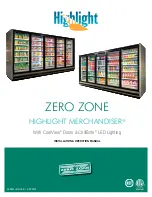
4 • Installation & Operation
INSTALLATION & OpERATION
INSTALLATION & OpERATION
Delivery Inspection
These display cases were carefully factory-tested, inspected, and properly packed to ensure delivery in the best possible condition. The
equipment should be uncrated and checked for damage immediately upon delivery. DAMAGE MUST BE NOTED AT TIME OF DELIVERY AND
ALL CLAIMS FOR DAMAGES MUST BE FILED WITH THE TRANSPORTATION COMPANY - NOT WITH Zero Zone. The carrier will supply
necessary report and claim forms.
Packaging
Each case in a lineup is labeled to identify the lineup and joint. The label uses a number and letter designation. The number indicates the lineup.
The letter indicates the case joint. Case joints begin with the letter A at the left most joint in the lineup when looking at the front of the lineup.
The joint for two cases has the same number-letter designation. Back-to-Back cases have a unique designation. The left most joint in the lineup
when looking at the front of the case is labeled 1-A. The joint on the back of the case is 1-A1.
Insulated dividers are factory-installed to separate low and medium temperature cases. They are also used to join different case models.
Factory-installed plexiglass dividers separate refrigeration circuits.
The first case in the lineup (with the right side labeled “A”) has a packet attached to the door handle that contains the manual, special
instructions for installing ordered options, and touch-up paint if the cases are custom painted. Every case in the lineup has a packet attached to
the door that contains the specific information for that case. The packing slip is taped to the right-hand door of each case.
Bumpers and kickplates are shipped on top of the case. Shelves for the case are tie-wrapped and blocked into the individual cases. Other
accessories like drain traps, drain pans, condensate evaporation pans, and hat channel rails are shipped in the case that require the parts.
Materials for joining cases include caulk, joining bolts, splices, and Case Joint Vertical Trim. These parts are supplied in cases that have a left-
side insulated divider or no left end. The parts are bagged and taped to the coil covers. The Case Joint Vertical Trim is tied to the shelves.
Location
These cases must not be installed in the direct rays of the sun or near a source of radiant heat.
Be certain that the floor under the installation is of sufficient strength to prevent sagging. Unlevel conditions will result in reduced performance.
Wall cases (cases set with a back to a wall) and cases set back-to-back, should be positioned to allow a minimum 3-4" space behind the back
of the unit(s). This will allow necessary air to circulate behind the display case(s). Higher humidity stores with minimal air circulation require a 4"
gap.
Recommended minimum 2" gap between cases on end-to-end installations.
Leveling
Cases must be installed perfectly level to allow efficient operation of the refrigeration coils and complete drainage of defrost water. Since a level
area is seldom available, the following steps are recommended to ensure a level installation.
1.
Measure off and mark on floor the exact dimensions of the case lineup.
(Check blueprints.)
2. Snap a chalk line at the locations for the front and back positions of the bases.
3. Mark locations of all joints (front and back).
4.
Using a laser or transit, find the highest point along both base rail position lines. Using the high point as a reference, mark the difference
directly on the floor to each base, front and back.























